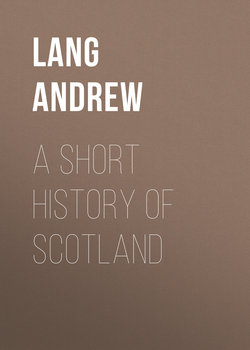A Short History of Scotland

Реклама. ООО «ЛитРес», ИНН: 7719571260.
Оглавление
Lang Andrew. A Short History of Scotland
CHAPTER I. SCOTLAND AND THE ROMANS
CHAPTER II. CHRISTIANITY – THE RIVAL KINGDOMS
CHAPTER III. EARLY WARS OF RACES
CHAPTER IV. MALCOLM CANMORE – NORMAN CONQUEST
CHAPTER V. DAVID I. AND HIS TIMES
CHAPTER VI. MALCOLM THE MAIDEN
CHAPTER VII. ENCROACHMENTS OF EDWARD I. – WALLACE
CHAPTER VIII. BRUCE AND THE WAR OF INDEPENDENCE
CHAPTER IX. DECADENCE AND DISASTERS – REIGN OF DAVID II
CHAPTER X. EARLY STEWART KINGS: ROBERT II. (1371-1390)
CHAPTER XI. JAMES I
CHAPTER XII. JAMES II
CHAPTER XIII. JAMES III
CHAPTER XIV. JAMES IV
CHAPTER XV. JAMES V. AND THE REFORMATION
CHAPTER XVI. THE MINORITY OF MARY STUART
CHAPTER XVII. REGENCY OF ARRAN
CHAPTER XVIII. REGENCY OF MARY OF GUISE
CHAPTER XIX. THE GREAT PILLAGE
CHAPTER XX. MARY IN SCOTLAND
CHAPTER XXI. MINORITY OF JAMES VI
CHAPTER XXII. REIGN OF JAMES VI
CHAPTER XXIII. THE GOWRIE CONSPIRACY
CHAPTER XXIV. CHARLES I
CHAPTER XXV. CONQUERED SCOTLAND
CHAPTER XXVI. THE RESTORATION
CHAPTER XXVII. WILLIAM AND MARY
CHAPTER XXVIII. DARIEN
CHAPTER XXIX. PRELIMINARIES TO THE UNION
CHAPTER XXX. GEORGE I
CHAPTER XXXI. THE ARGATHELIANS AND THE SQUADRONE
CHAPTER XXXII. THE FIRST SECESSION
CHAPTER XXXIII. THE LAST JACOBITE RISING
CONCLUSION
Отрывок из книги
To the Scots, through St Columba, who, about 563, settled in Iona, and converted the Picts as far north as Inverness, we owe the introduction of Christianity, for though the Roman Church of St Ninian (397), at Whithern in Galloway, left embers of the faith not extinct near Glasgow, St Kentigern’s country, till Columba’s time, the rites of Christian Scotland were partly of the Celtic Irish type, even after St Wilfrid’s victory at the Synod of Whitby (664).
St Columba himself was of the royal line in Ulster, was learned, as learning was then reckoned, and, if he had previously been turbulent, he now desired to spread the Gospel. With twelve companions he settled in Iona, established his cloister of cells, and journeyed to Inverness, the capital of Pictland. Here his miracles overcame the magic of the King’s druids; and his Majesty, Brude, came into the fold, his people following him. Columba was no less of a diplomatist than of an evangelist. In a crystal he saw revealed the name of the rightful king of the Dalriad Scots in Argyll – namely, Aidan – and in 575, at Drumceat in North Ireland, he procured the recognition of Aidan, and brought the King of the Picts also to confess Aidan’s independent royalty.
.....
But there were regions, notably the west Highlands and isles, where the new system penetrated slowly and with difficulty through a mountainous and almost townless land. The law, and written leases, “came slowly up that way.”
Under David, where his rule extended, society was divided broadly into three classes – Nobles, Free, Unfree. All holders of “a Knight’s fee,” or part of one, holding by free service, hereditarily, and by charter, constituted the communitas of the realm (we are to hear of the communitas later), and were free, noble, or gentle, – men of coat armour. The “ignoble,” “not noble,” men with no charter from the Crown, or Earl, Thane, or Church, were, if lease-holders, though not “noble,” still “free.” Beneath them were the “unfree” nativi, sold or given with the soil.
.....